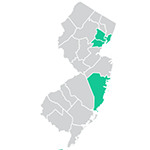Autism Prevalence Rates
Updated 3/23/2023
According to the most recent data from the Centers for Disease Control and Prevention (CDC), the national rate of children identified with Autism Spectrum Disorder is 1 in 36 children. This statistic is based on their evaluation of health and educational records of 8-year-old children in 2020 in 11 states, including New Jersey. New Jersey now has the third highest rate of autism in the nation: 1 in 35 children, or 2.9% of 8-year-old children.
Prevalence in 8-year-old children
About the rates
Autism prevalence in the U.S. has continued to increase without interruption since 2000, from .6% to 2.7%. In New Jersey, autism prevalence has been stable since 2016.
- Nationally, the prevalence of autism is 1 in 36 (2.7%).
- Here in New Jersey, it is 1 in 35 (2.9%)*
About the CDC study
Since the study began more than 20 years ago, the Autism and Developmental Disabilities Monitoring (ADDM) Network has been reviewing records of 8 year olds in New Jersey and across the country and issuing biennial reports on their prevalence findings. The 2023 prevalence report is from records reviewed in 2020.
In 2014, some of the states, including New Jersey, began studying 4-year-old children. The findings on 4 year olds offer a snapshot at an earlier point in time and, therefore, provide a means to monitor progress toward key initiatives such as ages of screening, evaluation, and diagnosis. The rates for 4-year-old children are currently 1 in 47 nationally and 1 in 40 in New Jersey.
Key take-away messages
Source: CDC 2023 Community Report
In its analysis, the CDC offers the following observations.
- Autism prevalence in the U.S. has continued increase without interruption since 2000, from .6% to 2.7%.
- 2020 autism prevalence estimates for 8-year-olds ranged from 2.3% (Maryland) to 4.5% (California). New Jersey had the third highest estimate (2.9%).
- Autism estimates for 4-year-olds ranged from 1.3% (Utah) to 4.6% (California), in 2020, indicating differences in autism diagnosis across the ADDM Network.
- Among 8-year-olds, the combined ADDM estimates showed autism prevalence was higher for Black and Hispanic children compared with White children. More Black children with autism also had intellectual disability compared with children from other racial ethnicity groups.
Dive deeper into the CDC’s data
Community Reports: Easy to understand summaries of the study and its data
2023 Community Report (Full)
A Snapshot of Autism Spectrum Disorder in New Jersey
Scientific Report: For the full peer-reviewed report and data
Morbidity and Mortality Weekly Report (MMWR) (March 24, 2023)
Additional Analysis
In January 2023, a Rutgers study explored prevalence data over time, specifically looking at autism spectrum disorder with and without Intellectual Disability (ID) and delays in diagnosis among certain groups. See coverage of their study.




